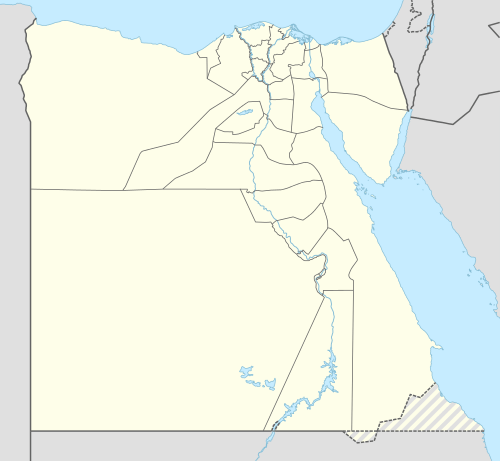Sais, Egypt
Coordinates: 30°57′53″N 30°46′6″E / 30.96472°N 30.76833°E
| Sais | |
|---|---|
|
Map of Sais ruins drawn by Jean-François Champollion during his expedition in 1828. | |
 Sais Location in Egypt | |
| Coordinates: 30°57′53″N 30°46′6″E / 30.96472°N 30.76833°E | |
| Country |
|
| Governorate | Kafr el-Sheikh |
| Time zone | EST (UTC+2) |
| • Summer (DST) | +3 (UTC) |
Sais (Ancient Greek: Σάϊς) or Sa El Hagar was an ancient Egyptian town in the Western Nile Delta on the Canopic branch of the Nile.[1] It was the provincial capital of Sap-Meh, the fifth nome of Lower Egypt and became the seat of power during the Twenty-fourth dynasty of Egypt (c. 732–720 BC) and the Saite Twenty-sixth dynasty of Egypt (664–525 BC) during the Late Period.[2] Its Ancient Egyptian name was Zau.
Overview
| Sais in hieroglyphs | ||||||
|---|---|---|---|---|---|---|
| ||||||
| Greek | Σάϊς (Sais) | |||||
Herodotus wrote that Sais is where the grave of Osiris was located and that the sufferings of the god were displayed as a mystery by night on an adjacent lake.[3]
The city's patron goddess was Neith, whose cult is attested as early as the 1st Dynasty, ca. 3100- 3050 BCE.[2] The Greeks, such as Herodotus, Plato and Diodorus Siculus, identified her with Athena and hence postulated a primordial link to Athens. Diodorus recounts that Athena built Sais before the deluge that supposedly destroyed Athens and Atlantis. While all Greek cities were destroyed during that cataclysm, the Egyptian cities including Sais survived.[4]
In Plato's Timaeus and Critias (around 395 B.C., 200 years after the visit by the Greek legislator Solon), Sais is the city in which Solon (Solon visited Egypt in 590 B.C.) receives the story of Atlantis, its military aggression against Greece and Egypt, its eventual defeat and destruction by gods-punishing catastrophe, from an Egyptian priest. Plato also notes the city as the birthplace of the pharaoh Amasis II.[5]
Plutarch said that the shrine of Athena, which he identifies with Isis, in Sais carried the inscription "I am all that hath been, and is, and shall be; and my veil no mortal has hitherto raised."[6]
There are today no surviving traces of this town prior to the Late New Kingdom (c.1100 BC) due to the extensive destruction of the city by the Sebakhin (farmers removing mud brick deposits for use as fertilizer) leaving only a few relief blocks in situ.[2]
Medical school
The Temple of Sais had a medical school associated with it, as did many ancient Egyptian temples. The medical school at Sais had many female students and apparently women faculty as well, mainly in gynecology and obstetrics. An inscription from the period survives at Sais, and reads, "I have come from the school of medicine at Heliopolis, and have studied at the woman's school at Sais, where the divine mothers have taught me how to cure diseases".[7]
See also
References
- ↑ Mish, Frederick C., Editor in Chief. "Saïs." Webster's Ninth New Collegiate Dictionary. 9th ed. Springfield, MA: Merriam-Webster Inc., 1985. ISBN 0-87779-508-8, ISBN 0-87779-509-6 (indexed), and ISBN 0-87779-510-X (deluxe).
- 1 2 3 Ian Shaw & Paul Nicholson, The Dictionary of Ancient Egypt, British Museum Press, 1995. p.250
- ↑ Herodotus, II, 171.
- ↑ Diodorus Siculus, Historical Library "Book V, 57".
- ↑ Plato, Timaeus.
- ↑ Plutarch, Isis and Osiris", ch. 9.
- ↑ Silverthorne, Elizabeth and Geneva Fulgham (1997). Women Pioneers in Texas Medicine. Texas A&M University Press. pp. xvii. ISBN 978-0-89096-789-8.
External links
| Wikimedia Commons has media related to Sais, Egypt. |
| Preceded by Tanis |
Capital of Egypt 732 – 720 BC |
Succeeded by Napata/Memphis |
| Preceded by Napata/Memphis |
Capital of Egypt 664 – 525 BC |
Succeeded by Persepolis(Achaemenid Empire) |
| Preceded by Babylon(Achaemenid Empire) |
Capital of Egypt 404 – 399 BC |
Succeeded by Mendes |
